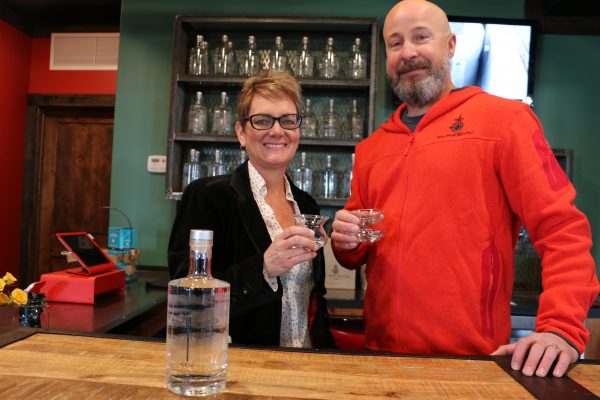
Ashley and Chris Cross have entered a world of botanicals, brews, spirits and a cozy store up in the Wasatch Back near Pine View Reservoir in Eden, Utah. Aptly, they have named their new business New World Distillery.
Ashley is a former school teacher and Chris is a former Navy Pilot and trainer. Together, they decided to open a distillery four years ago. It’s been a rigorous journey to buy stills, design bottles and packaging, outfit their store, pass the hundreds of regulations and cut through all the red tape required to start not just a small business, but the first and only distillery in the area. After a week in business, they see the light at the end of the tunnel, and it’s clear they are passionate about crafting fine spirits.
Ashley has mason jars filled with various botanicals that went into producing their gin: juniper berries, cinnamon, lemon peels, coriander. “Juniper berries are actually not berries at all but more similar to pine cones,” she tells me. Each ingredient has it’s own unique aroma that enliven the olfactory sense. We sample a half ounce. Gin, unlike vodka, is seeped with botanicals to produce a product that has something of a medicinal quality. For this reason, I’ve never been a fan of gin, because it tastes like medicine to me.
But trying Oomaw Gin with some ginger beer at home and a big cube of ice tastes healthy and refreshing. I learn from the book, “The Drunken Botanist,” that tonic should never be bought flavored with high fructose corn syrup, but should be real tonic, which can be found only at a few places, including Boozetique, in downtown Salt Lake.
Q Tonic derives its traditional bitter flavor from organic agave and Peruvian quinine (a compound derived from cinchona bark.) The ginger beer we have has no corn syrup and is made with real ginger. Back to the tour..
Chris shows me (in the manner others might show off their Porsche or Ferrari) the various high-tech stills he uses to make his product. The sophistication of his stills enables specific temperatures in every operation for optimal results. This is the case for not only their gin, but the vodka and agave spirits they plan to be producing soon.
Chris told us that a lot of the gin and craft spirits he buys are not properly aged or bottle-conditioned. Sometimes he opens a bottle that has a very harsh, biting flavor, when it should be smooth and mellow. Chris says that spirits must be bottle-conditioned for at least two weeks, which he assures us is built into his production process
Chris and Ashley have traveled extensively and their passion for opening a distillery originates from their love of fine agave spirits and tequila. “We were considering buying an agave farm,” says Ashley, “but we realized it would take years before we could harvest a final product, and we were more interested in the distillation side of things, where you have better control over the final product.”
Agave spirits are made unlike any other spirit in that they come from the agave plant, which contrary to population belief isn’t a cactus at all, but is more closely related to asparagus. The agave heart is harvested and roasted for the liquid, which is produced to begin the distillation process. Tequila can only be called such if the agave spirit is produced in specific regions in Mexico.
The distillery in Eden, Utah, is already busy. While we are there, locals come in smiling and preparing for Christmas dinners. It’s great to see that such a small town can support the burgeoning craft spirits industry. All over the country craft distilleries are popping up, and like the craft beer industry, are taking market shares from the giants who have been monopolies in the past.
Craft beer is a $22 billion industry in the U.S., with craft makers now taking a 12% market share of the entire $214 billion industry. The entire spirits industry in the U.S. is $23 billion annually. Wouldn’t it be great if small makers and small towns started getting a greater portion of this massive pie?
We encourage Utah lawmakers to make it easier for small distillers to produce, and for consumers to buy, local quality over factory-commodity-cost-saving-shareholder-profit-driven models (like 99% of the spirits produced in this country). Here’s to a New World!






